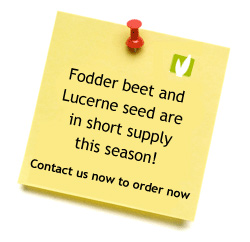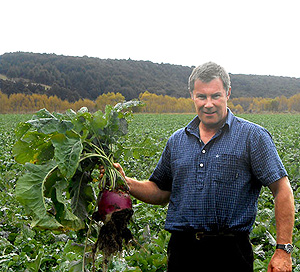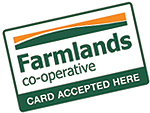 |
|
|
|
Issue 56 / Spring / October 2014
Hi #subname#
 Welcome to the October edition of Specialty Seed's SeedData Newsletter.
Welcome to the October edition of Specialty Seed's SeedData Newsletter.
As I write this the sun has been shining through the new Specialty Seed's office and nearly had me taking a Nana nap! However, luckily we are too busy for that sort of carry on.
The first of our fodder beet crops are being drilled and it appears that despite the seed supply difficulties we have had this season, most farmers will have access to their seed requirements.
If you are drilling fodder beet this season please remember it's critical to "Beet the Weeds". Weed control during the first 2-4 months of your fodder beets life will make the difference between success or failure…it's that simple.
If you have any questions on weed control or any other issue relating to your fodder beet crop please feel free to contact us.
Just like the seed supply, some of the chemicals required to spray fodder beet have been difficult to obtain this year. However, once again we should be able to help point you in the right direction for them as well.
In this month's edition we will look at the issue around the difficulty some farmers experienced when feeding their swede crops, my definitive dry land mix, yet another new white clover and Holdfast Phalaris.
This month we will cover the following topics:

HT Swede feeding issues with pregnant cows

I always know when there is a big news story doing the rounds in the farming community when my town friends ask me questions about what they have read in the newspaper.
This was certainly the case when about 6 - 8 weeks ago some rumours started coming out of Southland, and to a lesser degree other parts of New Zealand, that there were some major problems experienced by some farmers when grazing off their swede crops during late August and September.
Originally the finger of suspicion was pointed at one particular cultivar however to me it was difficult to fathom as we had sold many hectares of that same cultivar for the last two years with absolutely no issues what so ever reported by my clients, to me there had to be some degree of seasonal influence with this issue.
I've also been a bit slow in commenting on this rather sensitive problem as I wanted to wait until some of the heat came out of the issue, often it's a case of once the fire has been put out we get a better chance of finding the real cause of it.
My hat does go off to the seed industry who once again when faced with a difficult situation got quickly onto the front foot and worked long and hard with all effected parties to identify the cause and offer a solution into this very serious issue. For one of the better articles I saw explaining it please have a look at this NZ Farmer news article. Or should you have more questions or need more information feel free to contact us.
Download Link: Download the NZ Farmer: Pregnant cows in HT swedes warning: 06/10/14.
Contact Link: Contact Specialty Seeds for more information.
Back to top

NEW White clover: plant breeders strike again
Over the last two year's we have seen a lot of new white clovers released onto the market which I suppose is a good thing, although how a farmer can keep up with it I don't know?! It's hard enough for me!
 However, anytime we get a new cultivar on the market it is a good thing. This season we will have a limited amount of the new large leaf clover called "Legacy".
However, anytime we get a new cultivar on the market it is a good thing. This season we will have a limited amount of the new large leaf clover called "Legacy".
Legacy comes out of the AgResearch clover breeding program and will be marketed by PGG Wrightsons Seed and is only available Superstrike coated.
I'm told, that it is the highest yielding large leaf white clover on the market today! I will flick through the trial information once it has been finalised.
Contact Link: Contact Specialty Seeds if you have any questions on Legacy white clover.

Holdfast Phalaris
 During the last couple of seasons the supply of Phalaris has been unreliable which a shame is because we believe phalaris has a great role to play on New Zealand dry land farms.
During the last couple of seasons the supply of Phalaris has been unreliable which a shame is because we believe phalaris has a great role to play on New Zealand dry land farms.
Recently we have imported our own to ensure our clients have access to it we looked at trial results as well as "in the flesh" at the many options and decided to import Holdfast.
Holdfast was developed by the CSIRO Australia and is a semi erect, winter active variety, which forms thick dense tufts of wide blue/green leaves that are very palatable to sheep and cattle.
Holdfast has a low level of summer dormancy so it can respond and take advantage of any summer rainfall should it occur. Holdfast has excellent seedling vigour, which makes it a variety to establish quickly and easily.
This is very important for easier management of the stand should there be a high level of weed competition.
The deep rooted nature of Holdfast Phalaris draws nutrients back up to the top of the soil where they can be used, another major benefit from the plants deep roots system is it makes Holdfast very persistent under drought conditions.
We will have a limited amount of Holdfast available and would welcome any enquiry you may have.
Contact Link: Contact Specialty Seeds with any phalaris enquiries.

My definitive dry land mix
The following brews are ones that have taken so long to find and develop I wondered if I'd ever get there pre-retirement.
I'm happy to say I think I've achieved it with retirement still a long way away presuming a Lotto win doesn't come along and stuff everything up.
I think my journey to find a suitable dry land mix started way back during the droughts of the late 80's. During this time many new cultivars came through as the wonder cure for dry land farmers however they normally required such special management that they often ended in tears and I think it's fair to say they side tracked us for a long time. As you will see from the below mixes they don't re-invent the wheel but simply use what we deep down knew were the products to use….just updated them.
I have been mindful that these mixes should include deep rooting plants that by in large don't require grazing management a lot different from normal pasture management.
I have come up with two mixes one for spring sowing and one for autumn sowing, the only difference being the autumn one includes sub clover. The photo below will show you just how good these mixes can work when done right.
For more information on these mixes please contact us.
Dryland mix Spring sowing
Recommended sowing rate: 20 kgs/ha
- Cocksfoot
- Phalaris
- Lucerne (winter active)
- White clover x Caucasian clover cross
- Plantain
Dryland mix Autumn sowing
Recommended sowing rate: 25 kgs/ha
- Cocksfoot
- Phalaris
- Lucerne (winter active)
- White clover x Caucasian clover cross
- Plantain
- Sub clover (one early maturing + one late maturing)
Contact Link: Contact Specialty Seeds with any phalaris enquiries.
 As always, we hope this issue has been of some value to you. If you have a comment on this newsletter or anything on our website, please give us a call on our Freephone: 0800 727 8873, send us an email at: mail@specseed.co.nz. As always, we hope this issue has been of some value to you. If you have a comment on this newsletter or anything on our website, please give us a call on our Freephone: 0800 727 8873, send us an email at: mail@specseed.co.nz.
Kind Regards

Stephen Finch & David Percival
Specialty Seeds - New Zealand
|
|
|
|
 |
|
|

|
If you are having trouble viewing this email, .
If you would like to be removed from this newsletter please click here to
|
